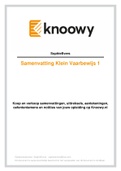Summary
Summary Global Strategic Management
- Course
- Institution
- Book
This summary is fully written in English. It contains all the powerpoint slides , information discussed in class AND additional information from the coursebook. The extensive explanations of the cases can be found at the end of the summary. - Also have a look at my profile for other summaries.
[Show more]













